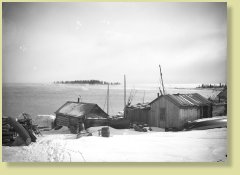Series I – Minnesota, Isle Royale, and Michigan, 1899-1937
 Series I (135 glass, 14 film; arranged by date) consists primarily of Minnesota scenes photographed from February to September 1899. Included in these early images is the first recorded photograph taken by Gleason on February 2, 1899—“Interior of Parlor and Hall, 1815 Columbus Av., Minneapolis, February 2, 1899.” The Gleasons lived at this address in 1899 before their return to Boston the same year. Gleason also photographed his mother-in-law’s home—“Mrs. Round’s House, 728 E. 18th St., Minneapolis, August 18, 1899.” Mrs. Rounds sold her house in Malden, MA in 1888 and moved to Minneapolis.
Series I (135 glass, 14 film; arranged by date) consists primarily of Minnesota scenes photographed from February to September 1899. Included in these early images is the first recorded photograph taken by Gleason on February 2, 1899—“Interior of Parlor and Hall, 1815 Columbus Av., Minneapolis, February 2, 1899.” The Gleasons lived at this address in 1899 before their return to Boston the same year. Gleason also photographed his mother-in-law’s home—“Mrs. Round’s House, 728 E. 18th St., Minneapolis, August 18, 1899.” Mrs. Rounds sold her house in Malden, MA in 1888 and moved to Minneapolis.
The Gleasons lived with Mrs. Rounds from 1890-1897 along with Mrs. Gleason’s sister Ethel and brother Fred. Of particular interest are images of the North Shore of Lake Superior taken in February 1899. Gleason provides an interesting description of this trip along the North Shore in his article “A Winter Ramble with a Camera” (Outing, January 1900). Among the North Shore images is “Logging Train on Trestle, Alger Camp No. 1, Knife River, February 8, 1899.” During the heyday of logging in this area, the Alger Smith Lumber Company was one of the principal log suppliers to the sawmills in Duluth.
Other North Shore images include the village of Grand Marais (views of fisherman huts, Hog Back, and an Indian grave); thomsonite rock, found locally on the beaches at Grand Marais; and surf views. Gleason photographed Isle Royale (established as a national park in 1940) and other islands in Lake Superior from the deck of the steamship "Dixon," which traveled Lake Superior between Duluth and Port Arthur and around Isle Royale carrying passengers, mail, supplies, and cargoes of fish. Included in the Isle Royale photographs are Siskiwit Light and Rock Harbor Light.
Other images in the series include a view of Sault Ste. Marie, MI from a train; Lester River and Lester Park in Duluth, MN; historic Fort Snelling (built in 1825 to control trade, exploration, and settlement along the Minnesota and Mississippi Rivers), the Indian Mounds, and Soldiers' Home in St. Paul, MN. The few Mounds in Gleason’s pictures are a remnant of what was once a large network of ancient Native American burial mounds in the area. Identified portraits include: Mr. and Mrs. Gilbert, Miss Janney, and Mrs. McKay and her daughter. Gleason made copies of historical images, including a painting of St. Anthony Falls in Minneapolis by Ferdinand Reichardt at the Minnesota Historical Society, and illustrations from books (Kirk’s Illustrated History of Minnesota and Minnesota in Three Centuries), and the Minnesota History Magazine.